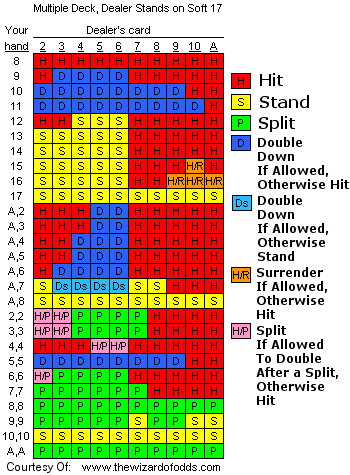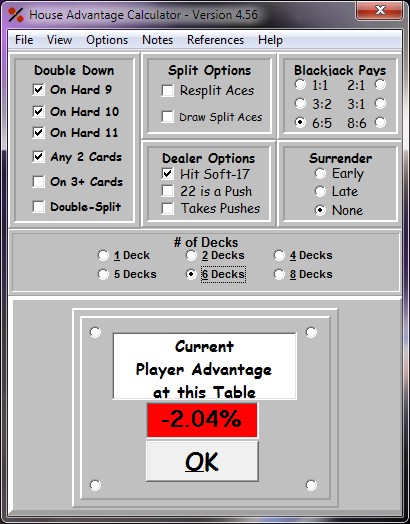Some blackjack tables pay 6:5 on winning naturals, and sometimes just even money. This is the most important of the common rules variants to pay attention to, as the 6:5 payout increases the house advantage by 1.4% and the even money payout increases it by an astounding 2.3%.
Determining the House Advantage

Have you ever wondered exactly what the house edge was for blackjack games with different rules?
I’ve put together an explanation of the most common rules variations including how each changes the house edge, for or against the player.
You’ll also find the total house edge for a few common rules combinations.
I find it easier to start with a set of rules and then add or subtract the house edge changes as rules are added or subtracted.
Once you get a solid understanding of the favorable and unfavorable rules you’ll quickly be able to tell a good table from a poor one. Most single rules don’t make a huge difference, but when you add three or four rules in one direction they can start adding up quickly.
Common Rules Edge
Before I cover how each specific rule changes the house edge I wanted to share the total house edge on a few common rules combinations. By seeing these combinations and the total house edge hopefully you can get a better understanding of the effect of each item covered below.
All of these are approximate and based on perfect blackjack basic strategy.
An 8 deck game where the dealer stands on a soft 17 where the player can double down on any two cards, can double after splitting and can split up to four hands has a house edge of roughly .45%. ( .45 is just under a half percent.) This is about as favorable as you can find in most casinos and if they offer these rules you should play.
If you find a 6 deck games with the same rules it reduces the house edge to just under .43%.

Blackjack 6 Deck Basic Strategy
An 8 deck game with the same rules except the dealer hits on a soft 17 increases the house edge to a hair over .66%.
Depending on where you play, finding blackjack games with decent rules can be difficult. Playing games with more than a .75 house edge is where I draw the line for my personal play. Of course I want it to be around a half percent or less, but if nothing better is available I will play a slightly worse game.
You need to set your own limits, but with the information included below you can determine what rules you can and can’t accept.
Number of Decks
The number of decks used changes the house edge. Though this may not seem like it should matter, the mathematicians have run the numbers over and over and it’s true.
A single deck game decreases the house edge by almost a half percent over an 8 deck game. The reduction is much smaller for a two deck game, coming in at just under .2%.
Four, five, and six deck games are only slightly better than 8 deck games, decreasing the house edge by .02 to .06%.
Dealer Hits or Stands on Soft 17
In games where the dealer hits on soft 17 the house edge is around .22% higher than when the dealer stands on a soft 7.
Player Can Double After Split
Whether or not you can double after splitting a pair is worth almost .15% for or against the house edge.
Player Can Split to Four Hands
It’s common for players to be allowed to split up to four hands. If you can only split to two hands it increases the house edge by .1%.
Player Can Re-split Aces
When you get another ace on one of your hands after splitting aces some tables let you split the aces again. If you’re allowed to re-split aces it reduces the house edge around .08%
Player Can Hit Split Aces
In games where you can draw to split aces it reduces the house edge by just under .2%.
Surrender
Six Deck Blackjack

Surrender isn’t a common rule, but if you can find games that offer it you can reduce the edge. You can find two different types of surrender; early and late.
Early surrender is the ability to fold your hand to receive half you bet back before the dealer checks for a blackjack. This reduces the house edge by almost .4%.
Late surrender is the other option which allows you to fold for half your wager after the dealer checks for blackjack and reduces the house edge by around .07%.
3 to 2 vs 6 to 5 vs 7 to 5 vs 1 to 1
Blackjack pays 3 to 2 on most tables. The difference in pay out percentage for other options is listed below, but I just ignore any tables that don’t pay at least 3 to 2.
Occasionally a casino will run a special or offer a coupon that offers a better pay out than 3 to 2 for a blackjack for a short time or for a single hand. If you ever have the opportunity to play a hand at 2 to1 you should do so. When blackjack pays 2 to 1 it reduces the house edge by over 2.25%, making even the worst games profitable for the player.
6 to 5 is the next most common payout for blackjack and it increases the house edge by almost 1.4%.
7 to 5 increase the house edge by around .45%.
1 to 1 is the worst and usually is only found on variations of blackjack that have a wide range of different rules. I don’t remember ever seeing a blackjack table only paying 1 to 1 for blackjacks. If a table only pays 1 to1 it increases the house edge by over 2.25%.
House Advantage Blackjack
Conclusion
Finding games with the best rules is one of the two big things every blackjack player needs to do in order to reduce the house edge as much as possible. Use the information above to learn how to determine if games offer a good pay back percentage or not.
6 Deck Blackjack Strategy
Once you find games offering good rules, combine them with basic strategy and you’ll give yourself the best chance to win and extend your bankroll as long as possible.